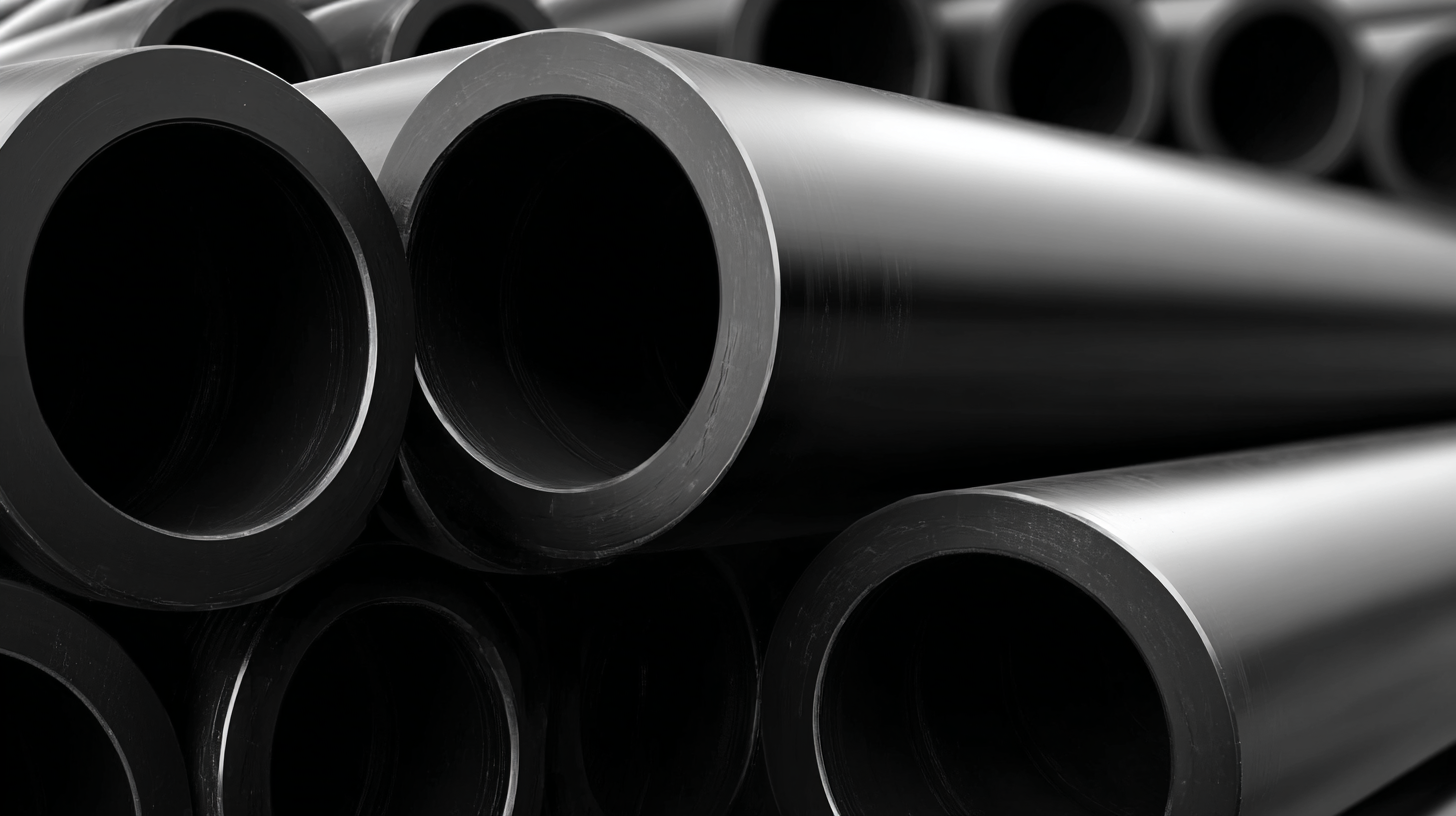-
Products and Systems
Products and Systems
Vinidex manufacturers and supplies a broad range of products & systems to suit a range of applications.
-
Solutions
Solutions
Vinidex’s products and systems are versatile and can be used in a variety of markets and applications.
- Resources
-
Exploring the Versatility of Black Plastic Pipe in Modern Infrastructure Solutions
In the realm of modern infrastructure solutions, black plastic pipe has emerged as a pivotal material, combining versatility, durability, and cost-effectiveness. According to a report by the National Association of Plumbing Contractors, the demand for black plastic pipe in construction and utility applications has surged, accounting for over 40% of the total piping market in recent years. This remarkable growth is driven by its resistance to corrosion and chemicals, making it ideal for various environments. Additionally, the U.S. Plastic Pipe Market reached an impressive valuation of $12 billion in 2020, with projections indicating continued expansion due to urbanization and infrastructure modernization initiatives. The adaptability of black plastic pipe in diverse applications, ranging from water supply systems to drainage solutions, highlights its significance in contemporary engineering practices. As industry standards evolve, understanding the comprehensive benefits of black plastic pipe is crucial for architects, engineers, and construction professionals aiming to create resilient and sustainable infrastructures.

Benefits of Using Black Plastic Pipe in Diverse Applications
Black plastic pipe, particularly in the form of high-density polyethylene (HDPE) and unplasticized polyvinyl chloride (uPVC), has become a foundational component in modern infrastructure solutions due to its myriad benefits. With the HDPE pipes market projected to reach USD 25.68 billion by 2029, the versatility of these materials is evident as they cater to various applications, including water supply, sewage, and telecommunications. Their lightweight nature, resistance to corrosion, and ease of installation make them an ideal choice for projects that require both efficiency and durability.
Moreover, the rise of the recycled plastic pipe market, estimated at USD 7.55 billion in 2024 and expected to hit USD 17.45 billion by 2033, underscores the sustainable shift within the industry. As more manufacturers embrace recycled materials, black plastic pipe solutions offer not only economic advantages but also contribute to environmental preservation. Applications span from agricultural irrigation to urban drainage systems, demonstrating the adaptability of black plastic pipes across diverse infrastructural needs while aligning with contemporary sustainability goals.
Key Factors for Selecting the Right Size and Type of Black Plastic Pipe
When selecting the right size and type of black plastic pipe for modern infrastructure solutions, several key factors must be considered. First, the intended application plays a crucial role in determining the pipe's diameter and wall thickness. For instance, larger diameter pipes are essential for high-flow systems, such as municipal water supply or drainage, while smaller pipes may suffice for residential plumbing or irrigation systems. Understanding the specific flow rates and pressure requirements is critical to ensure efficient and safe operations.

Another important consideration is the type of black plastic pipe, typically made from materials like HDPE or PVC. Each type offers distinct advantages, such as flexibility, resistance to corrosion, and ease of installation. Additionally, environmental factors, such as temperature fluctuations and exposure to chemicals, can influence material choice and long-term performance. By carefully evaluating these elements, engineers and contractors can select the most suitable black plastic pipe, ensuring reliability and durability in their infrastructure projects.
Installation Best Practices for Longevity and Efficiency
When considering the installation of black plastic pipe in modern infrastructure solutions, adhering to best practices is crucial for ensuring both longevity and efficiency. According to a report by the Plastics Pipe Institute (PPI), proper jointing techniques and the use of appropriate fittings can significantly enhance the lifespan of black plastic pipes, which are often made of high-density polyethylene (HDPE). Studies indicate that HDPE pipes can last over 50 years when installed correctly, making them a reliable choice for numerous applications, including water and gas distribution systems.
Additionally, it is essential to understand the environmental conditions that the pipes will be exposed to during installation. The American Society for Testing and Materials (ASTM) emphasizes that installing black plastic pipes below the frost line in colder regions can prevent freeze-thaw damage, which has been shown to reduce maintenance costs by up to 30%. Proper backfill material and compaction techniques also play a vital role; using a granular fill enables better drainage and minimizes the risk of pipe deformation. Following these installation best practices not only optimizes efficiency but also contributes to the overall sustainability of infrastructure projects.
Comparative Analysis: Black Plastic Pipe vs. Traditional Materials
When comparing black plastic pipe to traditional materials like metal and concrete, several critical factors come into play. Black plastic pipe, primarily made from high-density polyethylene (HDPE), offers significant advantages in terms of flexibility, ease of installation, and resistance to corrosion. Unlike traditional materials, which can be cumbersome and prone to rust or degradation over time, black plastic pipe is lightweight yet durable, making it a popular choice for modern infrastructure solutions.
**Tips**: When choosing pipe materials, consider the specific environmental conditions and requirements of your project. Black plastic pipe performs exceptionally well in areas with high soil moisture levels, where traditional materials may fail due to corrosion.
Furthermore, the cost-efficiency of black plastic pipe should not be overlooked. Installation is generally quicker and less labor-intensive compared to traditional materials, leading to reduced overall project costs. Additionally, the longevity and low maintenance requirements associated with black plastic pipe further enhance its position as a preferable option for many infrastructure projects.
**Tips**: Always consult with your local building codes and regulations, as they may dictate specific requirements for materials used in infrastructure projects.

Innovative Technologies Enhancing Black Plastic Pipe Performance
Black plastic pipe, primarily made from
high-density polyethylene (HDPE),
is becoming an integral component in modern infrastructure. Its lightweight nature,
durability, and resistance to corrosion make it a favorite for water distribution,
drainage, and sewage systems. Recent advancements in technology have further enhanced
the performance of these pipes, allowing for improved flow rates and greater longevity.
Innovations such as enhanced jointing techniques and the incorporation of advanced additives
are helping ensure black plastic pipes meet the rigorous demands of today's infrastructure.
Tips: When selecting black plastic pipe for your project,
consider the specific material properties, including its flexibility and resistance to environmental factors.
Additionally, opt for pipes with advanced joint systems to minimize leaks and ensure a long-lasting performance.
Regular inspection and maintenance can also extend the life of the piping systems and prevent costly repairs in the future.
Recent technologies such as smart sensors integrated into black plastic pipes are revolutionizing monitoring capabilities.
These sensors can detect pressure changes and potential leaks in real-time, providing data that helps optimize
water management and reduce wastage. This innovation not only enhances pipe performance but also contributes
significantly to sustainability efforts in urban planning. Adopting such technologies can lead to smarter,
more efficient infrastructure solutions that are crucial in the fight against climate change.

